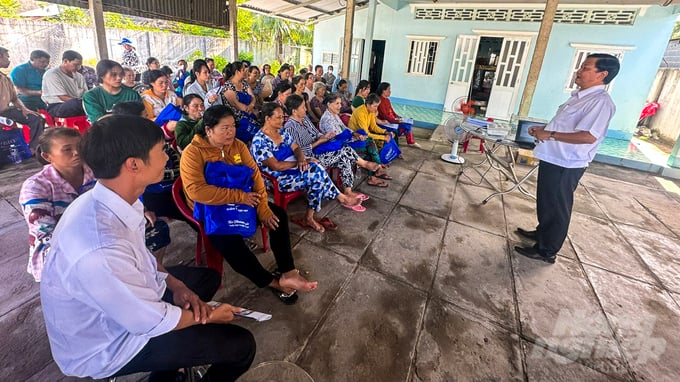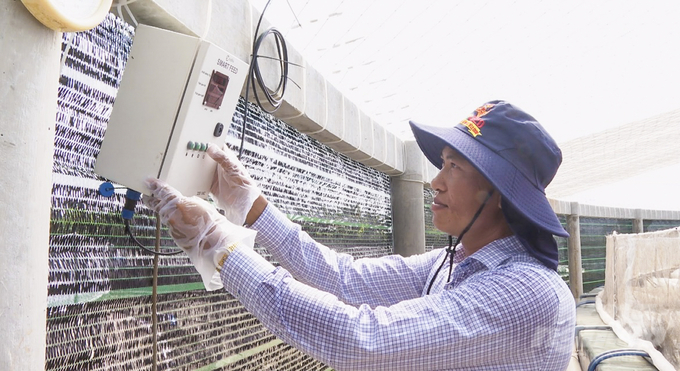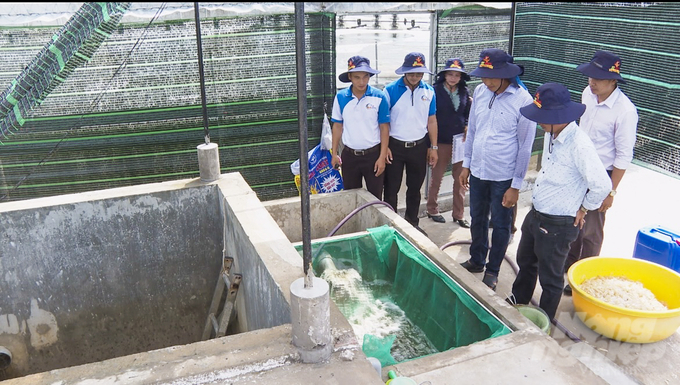May 16, 2025 | 10:27 GMT +7
May 16, 2025 | 10:27 GMT +7
Hotline: 0913.378.918
May 16, 2025 | 10:27 GMT +7
Hotline: 0913.378.918

The automatic feeding floor helps farmers balance the amount of feed for shrimp. Photo: Kim Anh.
The current Soc Trang witnesses a surge of mechanization applications in shrimp farming. Along with using a siphon system to remove pond bottom sludge, waste, and excess food, the pond environment becomes cleaner and more stable. The shrimp has been well cared for and managed throughout the development process in accordance with the motto “prevention is better than cure”.
Nguyen Van Man in Gia Hoa 1 commune (My Xuyen district) is currently applying this model. In the past, farmers mainly based on visual observation and experience to check the pond environment without relying on measuring tools, so the accuracy was not high and the shrimps were susceptible to disease. Now the siphon system helps him accurately identify water quality, detect diseases in shrimp early, which brings about higher production efficiency.
Tran De district is one of the localities strongly developing brackish water shrimp farming in Soc Trang province, with an annual farming area of over 4,500 ha. In the past 2 years, due to erratic developments in the weather, this type of economy is facing difficulties because of epidemics.
Soc Trang Sub-department of Livestock Production and Animal Health recently coordinates with Tran De District Farmer's Union to organize a training program called "Farming techniques and disease prevention for white leg shrimp" for farming households in Trung Binh commune. The goal is to provide basic knowledge about environmental management techniques in shrimp farming as well as disease prevention and treatment measures for farmed shrimp, improving productivity and production efficiency.

Soc Trang Sub-department of Livestock Production and Animal Health coordinates with Tran De District Farmer's Union to organize a training program for local shrimp farmers. Photo: Kim Anh.
Gaining knowledge about techniques for disease prevention and treatment of farmed shrimp is one of the important tasks to minimize damage to the shrimp industry.
According to Director of Soc Trang Sub-department of Livestock Production and Animal Health Lam Minh Hoang, this activity has been integrated into most action programs by the livestock production and animal health sector. The Sub-department also closely coordinates with local authorities to strengthen supervision and control of breed quality, establishing mobile aquatic veterinary testing teams to reach farming areas and support farmers.
To achieve efficiency and productivity, farmers are advised by experts to perform well in pond preparation. Particularly with new ponds, farmers need to properly dig and build the banks, spread lime to treat alum, then pour in water and disinfect the pond. As for old ponds, they need to drain the water, dredge and dry the pond, and reinforce the banks, then spread lime and add water.

It is easy to feed the shrimp nowadays. Farmers can control the system manually by using switches or installing an application on smartphone for remote interaction. Photo: Kim Anh.
Along with the development of science and technology, the majority of shrimp farming households in Soc Trang are very professional in using water environment monitoring equipment or installing automatic monitoring systems. Farmers measure environmental parameters twice a day, in the morning and afternoon, to accurately identify diseases in shrimp.
Statistics from Soc Trang Sub-department of Livestock Production and Animal Health show that feed costs in the province’s shrimp farming scene currently account for 50 - 60% of total investment costs. Therefore, managing and improving the feeding process proves to give a massive boost to the shrimp farming model.

Circulating water treatment system at Truong Ro Sa's shrimp farm. Photo: Kim Anh.
With a farming area of 4.4 ha, Truong Ro Sa in Khu 2 hamlet (Thanh Phu commune, My Xuyen district) is one of the pioneers that apply the rooftop shrimp farming model. He also invests in an automatic feeding floor at each pond. Thanks to that, feed is spread evenly, limiting loss.
Implementing the motto "farm the water first, farm the shrimp after", Ro Sa specially designs a 24/24 automatic water treatment system to help control toxic gases and waste in ponds, ensuring the quality of water supplied to each pond.
Rooftop shrimp farming combined with automatic feeding and water treatment has helped his family limit the impact of environmental factors. Shrimp grows in guaranteed conditions so it reaches a large size when harvested. In two consecutive crops, Ro Sa is able to harvest batches of shrimp with a size of 15 shrimp/kg.
Translated by Samuel Pham

(VAN) Cold-barn systems efficiently manage environmental and temperature conditions, which aids in the prevention of respiratory diseases in pigs and protects them from the vectors that transmit African swine fevers.

(VAN) To tackle challenges, the project 'Addressing key technical bottlenecks in the grouper supply chain in Vietnam' has been underway since 2024.

(VAN) The project 'Disease-Resilient and Sustainable Cassava Production Systems in the Mekong Region', funded by the Australian Center for International Agricultural Research (ACIAR), is being implemented from 2024 to 2028.

(VAN) Data from 10,000 farming households will help professionalize production organization and support the implementation of the One Million Hectares Program for High-Quality, Low-Emission Rice Cultivation.

(VAN) FAO Director-General QU Dongyu marks International Day of Plant Health at NENA conference.

(VAN) Deputy Minister of Agriculture and Environment Hoang Trung affirmed that floriculture and ornamental plants are a growing industry that receives significant global attention.

(VAN) The three staple crops dominating modern diets – corn, rice and wheat – are familiar to Americans. However, fourth place is held by a dark horse: cassava.